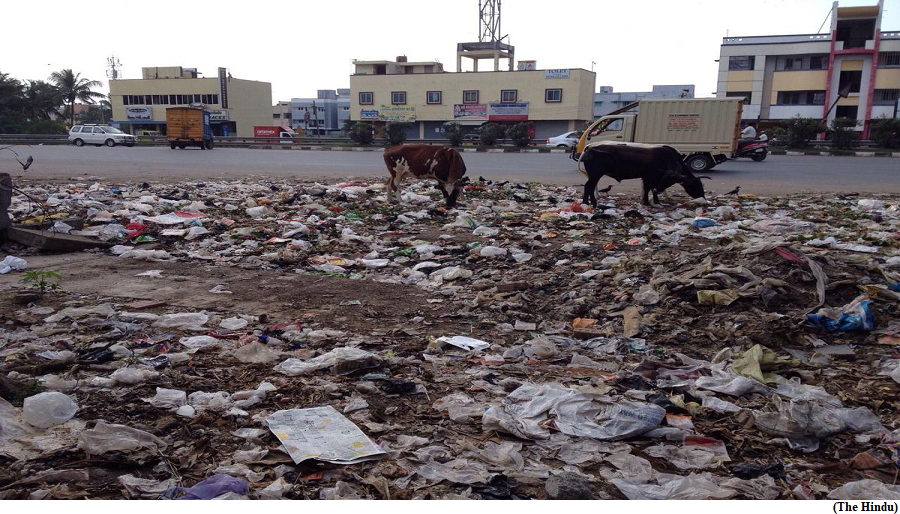Stray dogs and poor waste management (GS Paper 2, Governance)

Why in news?
- Frequent reports of dogs attacking people to death have made the management of stray dogs an administrative and legal issue in India.
What do dog bites have to do with poor waste management?
- The “carrying capacity” is determined by the availability of food and shelter.
- Free-ranging dogs, in the absence of these facilities, are scavengers that forage around for food, eventually gravitating towards exposed garbage dumping sites. Dogs thus congregate around urban dumps, such as landfills, due to feeding opportunities.
- A population boom in Indian cities has contributed to a staggering rise in solid waste. Indian cities generate more than 1,50,000 metric tonnes of urban solid waste every day.
- According to a United Nations Environment Program 2021 report, an estimated 931 million tonnes of food available to consumers ended up in households, restaurants, vendors and other food service retailers’ bins in 2019.
- Indian homes on average generated 50 kg of food waste per person. This waste often serves as a source of food for hunger-stricken, free-roaming dogs that move towards densely-populated areas in cities, such as urban slums which are usually located next to garbage dumping sites and landfills.
What role does urbanisation play?
- Cities have witnessed a sharp increase in the stray dog population, which as per the official 2019 livestock census stood at 1.5 crore. However, independent estimates peg the number to be around 6.2 crore.
- The number of dog bites has simultaneously doubled between 2012 and 2020. India also shoulders the highest rabies burden in the world, accounting for a third of global deaths caused due to the disease.
- In 2015, a study conducted in 10 Indian metro cities found a strong link between human population, the amount of municipal and food waste generated, and the number of stray dogs in the cities.
Correlation between urbanisation & solid waste production:
- While there is no evidence to show that a rising population and municipal waste directly led to an increase in dog bites, experts agree there may be a correlation between urbanisation and solid waste production, made visible due to the mismanagement of waste disposal.
- Tepid animal birth control programmes and insufficient rescue centres, in conjunction with poor waste management, result in a proliferation of street animals in India.
- Additionally, most landfills and dumping sites are located on the peripheries of cities, next to slums and settlement colonies. Thus, the disproportionate burden of dog bites may also fall on people in urban slums.
- A study published in 2016 found that the prevalence of dog bites was higher in urban slums usually located in close proximity to dumping sites than rural slums.
How has India managed the problem?
- India’s response to the “stray dog menace” has relied upon the Animal Birth Control (ABC) programme, through which municipal bodies trap, sterilise and release dogs to slow down the dog population.
- The second anchor was rabies control measures, including vaccination drives.
- But implementation suffers from low awareness around the health implications of dog bites, irregular supply of vaccines, delay in seeking treatments, and a lack of national policy.
The protests against the refinery project in Maharashtra
(GS Paper 3, Economy)
Why in news?
- Recently, the Maharashtra government started conducting soil testing at Rajapur tehsil’s Barsu village in the coastal Ratnagiri district to know if the site was suitable for the proposed multi-billion dollar Ratnagiri Refinery and Petrochemicals Limited project which is touted as the world’s largest single location refinery complex.
- As of April 2022, India’s oil refining capacity stood at 251.2 million metric tonnes per annum, making it the second-largest refiner in Asia and the fourth largest in the world.

What is the Barsu refinery project?
- The project, which is expected to have a capacity of 60 million tonnes per annum, is a joint venture between Saudi Aramco, Abu Dhabi National Oil Company (ADNOC), Indian Oil Corporation Limited, Bharat Petroleum Corporation Limited, and Hindustan Petroleum Corporation Limited.
- The project was initially mooted in 2014 and is estimated to cost around rupees three lakh crore.
- Besides fuel, the project also proposes to develop various downstream petrochemicals to meet India’s fast-growing petrochemical demand.
- Initially, the project was supposed to come up at Nanar, about 20 kilometres from Barsu. However, due to strong opposition from the locals, environmental activists and the Shiv Sena, the project was denotified in 2019.
How have the villagers reacted?
- Hundreds of residents from Barsu-Solgaon and neighbouring villages are protesting the government’s decision as they are concerned about the potential impact on the environment and the livelihoods of local communities.
- The project site is in a region that is ecologically sensitive, with several species of flora and fauna endemic to the area. The Konkan region has large mango orchids as well as jack fruit and cashew plantations.
- The villagers also expressed concern about the potential health hazards posed by the refinery and petrochemical unit, which is expected to emit a large amount of pollutants.
- According to locals, Konkan already suffers from air pollution due to the presence of coal-fired power plants. Many farmers expressed concern that they would lose their source of livelihood if their land is acquired for the project.
- Locals say that the project should be shifted to more arid zones in the State like Marathwada and Vidarbha.
What is the State govt.’s stand?
- In November 2021, the Shinde-Fadnavis government started issuing land acquisition notices to residents of six villages to acquire the initial 2,220 acres of land.
- It has been a strong supporter of the project and argued that it would help reduce India’s dependence on crude oil imports and provide a boost to the economy, apart from generating employment for over one lakh people, both direct and indirect.



